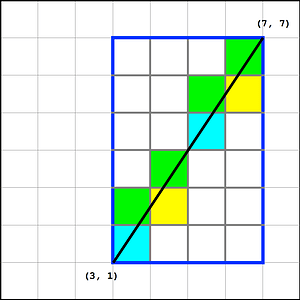PROBLEM LINKS
DIFFICULTY
EASY
PREREQUISITES
Simple Math
PROBLEM
On a standard 2D grid, you draw a line between two lattice points, (x1, y1) and (x2, y2) respectively.
You wish to find the number of grid cells that the line crosses over. Ignore the grid cell if the line never actually enters inside the cell.
EXPLANATION
Without loss of generality we may assume that
x1 < x2 AND y1 < y2
Imagine that the line is actually a ray directed from (x1, y1) to (x2, y2); or from the bottom-left point to the top-right point. Let us take a non-trivial example and break the problem apart.
The image above extends the sample the problem statement has, a little bit further. It also offers some valuable insights
The smallest subproblem
The problem can be split into many subproblems. Each of these subproblems exisst for a line segment of the same length, embedded within a rectangle of the same dimensions.
But how do we know how many subproblems can we split the main problem into?
Insight 1
Everytime the ray touches a lattice point, a new smallest sub-problem may be built.
This can be seen in our example above. The line enters at the exact same angle in both the Cyan colored cells. Of course, the shape of the regions of cells the line goes through between consecutive lattice points will be exactly the same. So will be, the number of cells that the line goes through.
Insight 2
The problem can be split into exactly GCD(x2-x1,y2-y1) smallest subproblems.
From Insight 1, we know that we wish to know the number of lattice points the ray touches after starting from (x1, y1). Let
Dx = (x2 - x1) Dy = (y2 - y1) x = x1 + Dx * t y = y1 + Dy * t
We wish to find (x, y) which are integers for all
t ∈ (0, 1]
t must divide both Dx and Dy. Since Dx and Dy are integers, t cannot be irrational. So let us assume that
t = p / q
q must divide both Dx and Dy. For this, q must be a common divisor of Dx and Dy. In fact, we only need to consider the greatest common divisor of Dx and Dy. (For all other values of q, we can always multiply both p and q with a constant and the denominator will be the GCD of Dx and Dy - hence, it will be a redundant value of q to consider)
Thus
q = GCD(Dx,Dy) p = [1, 2 .., q]
To summerize, there are only GCD(Dx,Dy) smallest subproblems.
Solve the smallest subproblem
Now we are assured that the ray will not cross any other lattice points except the first and the last on its path. The only events the ray may enounter on its journey are
- cross a horizontal grid line
- cross a vertical grid line
Insight 3
The ray can never cross the same grid line twice.
Insight 4
The ray enters a new cell everytime it crosses a grid line.
Note in the image above
- The ray enters the cells filled with Green when the ray crosses a vertical grid line
- The ray enters the cells filled with Yellow when the ray crosses a horizontal grid line
Thus, we have a one by one mapping to the cells the ray enters, and the grid line the ray crosses. This means that we can simply add up the number of grid lines in a subproblem to calculate the number of cells the ray touches.
Hence the number of cells the ray touches in a subproblem is
(Dx - 1) + (Dy - 1) + 1 Dx = difference in x-coordinate in subproblem Dy = difference in y-coordinate in subproblem
- (Dx - 1) is the number of horizontal grid lines in the subproblem
- (Dy - 1) is the number of vertical grid lines in the subproblem
- 1 accounts for the initial cell the ray is in.
If you’re wondering why this simple insight won’t apply to the complete problem, consider the anomaly that when the ray crosses a lattice point, it crosses two grid lines, but enters only one new cell. That is why, we first break everything to a subproblem where this cannot happen.
Solve the problem
The answer can be calculated by the following pseudo-code.
Dx = x2 - x1 Dy = y2 - y1 G = GCD(Dx,Dy) dx = Dx / G dy = Dy / G answer = ((dx - 1) + (dy - 1) + 1) * G
Thus, the answer can be found in constant time.
CODE COMMENTARY
There is a glorious pitfall left open for unaware participants.
The problem does not put any constraints on Dx and Dy. What if one of them is 0?
The GCD in this case is still well defined. The answer is well defined as well. If you follow the above calculation closely, you will automatically get an answer of 0. But you should be careful about your implementation.
SETTER’S SOLUTION
Can be found here.
TESTER’S SOLUTION
Can be found here.
